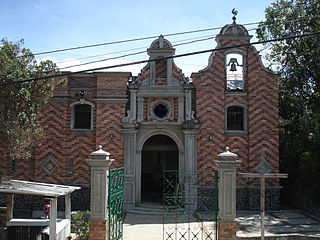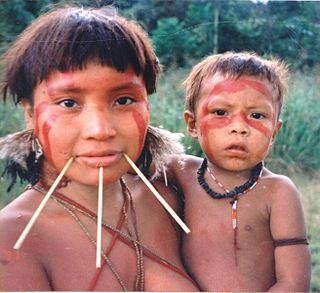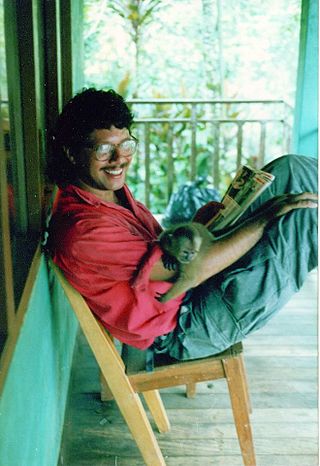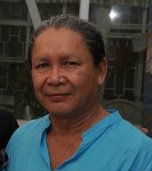Related Research Articles

The Arawak are a group of indigenous peoples of northern South America and of the Caribbean. Specifically, the term "Arawak" has been applied at various times from the Lokono of South America to the Taíno, who lived in the Greater Antilles and northern Lesser Antilles in the Caribbean. All these groups spoke related Arawakan languages.

Gerardo Reichel-Dolmatoff was an Austrian anthropologist and archaeologist. He is known for his fieldwork among many different Amerindian cultures such as in the Amazonian tropical rainforests, and also among dozens of other indigenous groups in Colombia in the Caribbean Coast, as well as others living in the Pacific Coast, Llanos Orientales, and in the Andean and inter-Andean regions (Muisca) as well as in other areas of Colombia, and he also did research on campesino societies. For nearly six decades he advanced ethnographic and anthropological studies, as well as archeological research, and as a scholar was a prolific writer and public figure renowned as a staunch defender of indigenous peoples. Reichel-Dolmatoff has worked with other archaeologists and anthropologists such as Marianne Cardale de Schrimpff, Ana María Groot, Gonzalo Correal Urrego and others. He died 17 May 1994 in Colombia.

Arawakan, also known as Maipurean, is a language family that developed among ancient indigenous peoples in South America. Branches migrated to Central America and the Greater Antilles in the Caribbean and the Atlantic, including what is now the Bahamas. Almost all present-day South American countries are known to have been home to speakers of Arawakan languages, the exceptions being Ecuador, Uruguay, and Chile. Maipurean may be related to other language families in a hypothetical Macro-Arawakan stock.

The Kalina, also known as the Caribs or mainland Caribs and by several other names, are an Indigenous people native to the northern coastal areas of South America. Today, the Kalina live largely in villages on the rivers and coasts of Venezuela, Guyana, Suriname, French Guiana, and Brazil. They speak a Cariban language known as Carib. They may be related to the Island Caribs of the Caribbean, though their languages are unrelated.

The Piaroa people, known among themselves as the Huottüja or De'aruhua, are a pre-Columbian South American indigenous ethnic group of the middle Orinoco Basin in present-day Colombia and Venezuela, living in an area larger than Belgium, roughly circumscribed by the Suapure, Parguaza (north), the Ventuari (south-east), the Manapiare (north-east) and the right bank of the Orinoco (west). Their present-day population is about 15,000 (INE 2002), with an estimated 2,500 living on the left bank of the Orinoco River, in Colombia, in several reservations between the Vichada (north) and the Guaviare (south).
Bride service has traditionally been portrayed in the anthropological literature as the service rendered by the bridegroom to a bride's family as a bride price or part of one. Bride service and bride wealth models frame anthropological discussions of kinship in many regions of the world.
The Piaroa–Saliban, also known as Saliban, are a small proposed language family of the middle Orinoco Basin, which forms an independent island within an area of Venezuela and Colombia dominated by peoples of Carib and Arawakan affiliation.
Darrell Addison Posey was an American anthropologist and biologist who vitalized the study of traditional knowledge of indigenous and folk populations in Brazil and other countries. He called his approach ethnobiology and combined research with respect for other cultures, especially indigenous intellectual property rights.

The Yanomami, also spelled Yąnomamö or Yanomama, are a group of approximately 35,000 indigenous people who live in some 200–250 villages in the Amazon rainforest on the border between Venezuela and Brazil.

Eduardo Batalha Viveiros de Castro is a Brazilian anthropologist and a professor at the National Museum of the Federal University of Rio de Janeiro.
Setha M. Low is a former president of the American Anthropological Association, a professor in environmental psychology, and the director of the Public Space Research Group at the City University of New York. Low also served as a Conservation Guest Scholar at the Getty Conservation Institute.

Nicholas J. Saunders is a British academic archaeologist and anthropologist. He was educated at the universities of Sheffield, Cambridge, and Southampton. He has held teaching and research positions at the National Autonomous University of Mexico, the University of the West Indies, Dumbarton Oaks, Washington D.C., and at University College London, where he was Reader in Material Culture, and undertook a major British Academy sponsored investigation into the material culture anthropology of the First World War (1998–2004). As of 2014 Saunders was Professor in the Department of Anthropology and Archaeology at the University of Bristol, where he was responsible for the MA programmes in historical archaeology and conflict archaeology. As of 2018, he is Emeritus Professor of Material Culture in that department. He is a prominent contributor to the nascent field of conflict archaeology, and has authored and edited numerous academic publications in the field. In addition to his research specialising in the anthropology of 20th-century conflicts and the archaeology of World War I theatres in Belgium, France and the Middle East, Saunders has also conducted extensive fieldwork and research in pre-Columbian and historical archaeology of the Americas. He has been involved with major museum exhibitions in London, Ypres (Belgium), Tübingen (Germany), and at the Centre Pompidou-Metz (France). Saunders has investigated and published on material cultures and landscapes of Mesoamerica, South America, and the Caribbean. His most recent research has been on the aesthetics of brilliance and colour in indigenous Amerindian symbolism, an extensive survey investigation of the Nazca Lines in Peru, the anthropological archaeology of twentieth-century conflict and its legacies along the Soca (Isonzo) Front on the Slovenian-Italian border, and the conflict artworks of the Chinese Labour Corps on the Western Front during and after the First World War.

Indigenous people in Venezuela, Amerindians or Native Venezuelans, form about 2% of the total population of Venezuela, although many Venezuelans are mixed with Indigenous ancestry. Indigenous people are concentrated in the Southern Amazon rainforest state of Amazonas, where they make up nearly 50% of the population and in the Andes of the western state of Zulia. The most numerous indigenous people, at about 200,000, is the Venezuelan part of the Wayuu people who primarily live in Zulia between Lake Maracaibo and the Colombian border. Another 100,000 or so indigenous people live in the sparsely populated southeastern states of Amazonas, Bolívar and Delta Amacuro.

Peter G Gow was a social anthropologist, renowned for his work in Amazonia. He was a Professor of Social Anthropology at the University of St Andrews and has previously taught at the London School of Economics.

Steven Lee Rubenstein was an American anthropologist. He was reader in Latin American Anthropology at the University of Liverpool, and Director of Liverpool's Research Institute of Latin American Studies.

Peter G. Rivière is a British social anthropologist, Emeritus Professor of Oxford University and, with Audrey Butt Colson, a pioneer in the study and teaching of Amazonian peoples in England. In 1957-8 he took part in the Oxford and Cambridge Expedition to South America.

George Simon was a Guyanese Lokono Arawak artist and archaeologist. He was the founder and mentor of the Lokono Artists Group, a group of Lokono artists from Guyana, based primarily in his hometown of St. Cuthbert's Mission. Simon was widely regarded as one of the leading Guyanese artists of his generation, and his paintings are notable for their explorations of Amerindian culture and the Guyanese environment. He was also recognized for his achievements as an educator, his efforts to develop opportunities for Amerindian artists in Guyana, and for his work as an archaeologist.
June C. Nash was a social and feminist anthropologist and Distinguished Professor Emerita at the Graduate Center of the City University of New York. She conducted extensive field work throughout the United States and Latin America, most notably in Bolivia, Mexico and Guatemala. She was also a part of feminist and working class social movements such as that of the Zapatistas in Mexico.
Audrey Joan Butt Colson, is a social anthropologist with a particular interest in the Amerindian peoples of Guyana, Brazil and Venezuela. She was, together with Peter Rivière, one of the pioneers of Amazonian anthropology at the University of Oxford.
Norman E. Whitten, Jr. is an American cultural anthropologist who is Professor Emeritus of Anthropology and Latin American Studies at the University of Illinois Urbana-Champaign, and Curator of the Spurlock Museum of World Cultures. He is known for books based on his anthropological field work and his research on the Afro-Latin and Indigenous peoples of the West Coast rainforest and upper Amazon Rain forest, most notably the Black population and Canelos Quichua and Achuar Peoples.
References
- 1 2 "Social Anthropology at St Andrews: Staff profiles". www.st-andrews.ac.uk. Retrieved 2017-05-11.
- ↑ Andrews, Mike Arrowsmith, CAS, University of St. "Centre for Amerindian, Latin American and Caribbean Studies (CAS)". www.st-andrews.ac.uk. Retrieved 2017-05-11.
{{cite web}}: CS1 maint: multiple names: authors list (link) - ↑ Walker, Harry (2015-12-23). "Joy within tranquility: Amazonian Urarina styles of happiness" (PDF). HAU: Journal of Ethnographic Theory. 5 (3): 177–196. doi:10.14318/hau5.3.010. ISSN 2049-1115. S2CID 56443518.